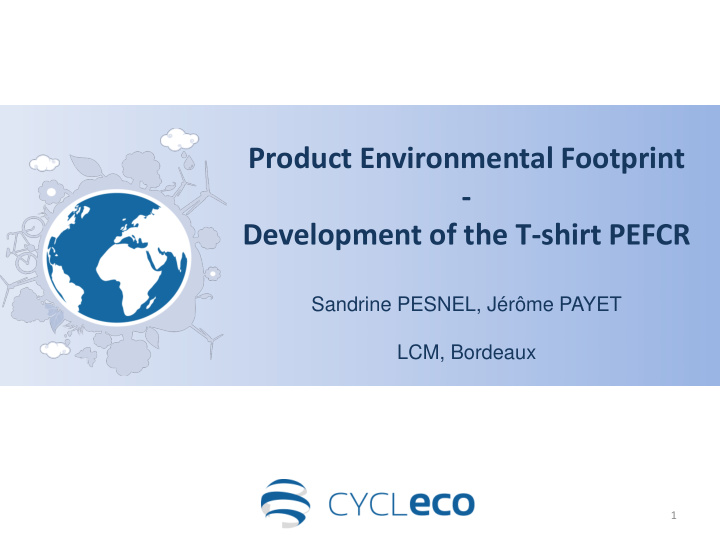



Product Environmental Footprint - Development of the T-shirt PEFCR Sandrine PESNEL, Jérôme PAYET LCM, Bordeaux 1
Agenda • Environmental Footprint pilot phase • T-shirt pilot • PEFCR development process – Scope definition – Definition of the representative product – PEF screening – Draft PEFCR – Next steps 2
Environmental Footprint pilot phase • European Commission: • Several initiatives on – To homogenize the different product environmental methodologies footprint – LCA based methods: PEF and OEF – Lack of consistency, barrier – Between 2013 and 2016, for the circulation of green organization of an experimental products phase • Objectives – Test the process for the development of PEFCRs and OEFSRs – Facilitate the implementation of environmental impact methods (SMEs) – Test different approaches for verification systems – Experiment several approaches to B2C and B2B communication • Call for volunteers – 1 st wave: 14 PEFCRs (T- shirt…), 2 OEFSRs – 2 nd wave: 11 PEFCRs 3
T-shirt pilot Retailers Producers Teintures et Apprêts Danjoux Les Tissages de Charlieu Public authorities Swiss federal office of the environment French Ministry for Ecology, Sustainable Development and Energy LCA consultant ADEME (coordinator) 4
PEFCR development process • PEFCR: Product Environmental Footprint Scope definition Category Rules Definition of the representative product • Progress of T-shirt pilot PEF screening Draft PEFCR PEFCR supporting studies Confirmation of benchmarck and determination of performance classes Final PEFCR 5
Scope definition • Analysis of existing PCRs – Study of the alignment of PCRs with PEF guide (procedural, data and rule alignment) • Definition of the scope – Functional unit • What?, how much?, how well? and how long? • “One T -shirt fit to be worn, once a week, and cleaned during one year” – CPA code: C14.14.3 “T -shirts, singlets and other vests, knitted or crocheted” – Definition of the product category • “ Apparel products that are fit to dress the upper body, mainly consisting of a knitted fabric (at least 51% of the product weight), without complete opening (from top to bottom) on the chest. Knitted fabric is produced by circular or tubular knitting with thin gauge (higher 6 than 16) and its surface density is less than 240 g/m² ”
Def. of the representative product • What is the RP? – ‘ Average ’ product existing in the EU market • Methodology – Virtual product /real product – At least 1 RP per product category – Definition of the life cycle of RPs • T-shirt application: – 5 RP: men, women, children 2-7 years old, children 8-14 years old, babies (weight and composition differences) – 2 types of data: • Market data: composition (77% cotton), sewing location, end-of- life… • Real data (from TS): finishing, packaging, % of plane for transport… – Modelling of use phase: consumer behaviour ( drying, lifetime…) 7
PEF screening • Use? – Support the PEFCR development (for data collection and data quality priorities) • Methodology – LCA of the RPs + sensitivity analyses – Identification of: • Environmental hotspots Criteria • Most relevant processes and life cycle defined by the EC stages • Most relevant impact categories • Data quality needs Preliminary • Definition of the benchmark for the indication product category in scope 8
Production of Production of Production Most Production of synthetic regenerated of raw relevant life natural fibres materials fibres materials cycle stages T T T Spinning Knitting Dyeing T T T Production Sewing Finishing Printing of T-shirt Accessories Packaging Transport Transport to warehouse of the final Transport to shops product Distribution Customer travel Use Washing Drying Ironing phase T-shirt end Pastic bag Cardboard End of of life end of life end of life life Transport: truck, boat, and/or plane 9
Production of Production of Production Most Production of synthetic regenerated of raw relevant life natural fibres materials fibres materials cycle stages T T T Most Spinning Knitting Dyeing T relevant T T Production Sewing Finishing Printing processes of T-shirt Accessories Packaging Most relevant PEF impact categories Transport Transport to warehouse of the final - Climate change Transport to shops product - Particulate matter Distribution Customer travel - Freshwater eutrophication Use Washing Drying Ironing - Marine phase eutrophication - Resource T-shirt end Pastic bag Cardboard End of depletion of life end of life end of life life Transport: truck, boat, and/or plane 10
Draft PEFCR • Main content: – PEFCR scope (selection of the indicators) – Data quality requirements – Data collection – Identification of specific and generic data – Benchmark and classes of environmental performance – Reporting, disclosure and communication (PEF label, websites of companies) – Verification • Methodology: – “Data requirements – Dataset needs (data in Product collection / data quality) Consultation Environmental • Relevant / non in September Footprint Category relevant processes Rules (PEFCRs )” • Situations 1/2/3 (v0.3) 11
Next steps • Supporting studies: – At least 3 PEF studies – Application of the PEFCR – On existing products as currently sold in the European market • Confirmation of benchmark and determination of performance classes: – Based on the RP and the supporting studies Consultation • Final PEFCR: – Review of the final PEFCR by external reviewers – Approval of final PEFCR by Steering Committee 12
Thank you for your attention. sandrine.pesnel@cycleco.eu www.cycleco.eu 13
Recommend
More recommend